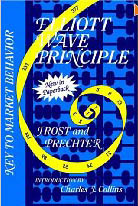Eliott Wave Theory

At the end of the 1930s, Ralph Nelson Elliott (1871-1948) published the "Wave Principle", having been inspired by Dow's theory and Italien mathematician Fibonacci's golden number.
Elliott believes that the markets don't evolve in a random manner, but instead follow repeated trend cycles (up or down) that are influenced by nature and human behavior.
These financial market movements are characterised by phases of five trend waves and three consolidation waves.
Elliott defined precise rules in his theory, using established chart paterns.
The Elliott Waves cycle
Example using a Forex chart
The impulse wave
The corrective wave
The formation of waves

The Elliott Wave Principle: 20th Anniversary Edition: Key to Market Behavior
Reviews:
"This book is extremely well done. It is clear, brief and bold....by far the most useful and comprehensive for both the beginner and the veteran." William Dilanni, Wellington Mgmt. Co.
"An outstanding job...I don't think a better basic handbook of Elliott Wave theory could be written." Donald J. Hoppe, Business and Investment Analysis
"...A top–drawer reference for serious technical analysts....all the nuts and bolts necessary to do their own Elliott Wave assembly." Futures Magazine
"Chapter Three is the best description of Fibonacci numbers we've seen in print and that alone is worth the price of the book." Janes Dines, The Dines Letter
"In a third of a lifetime in this business, this was the first time I really understood Elliott, and this is certainly the first book on Elliott that I could recommend. All the methods that Prechter has used so successfully are fully described in this book." The Professional Investor